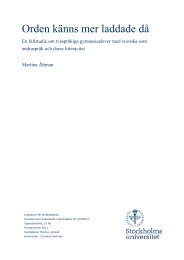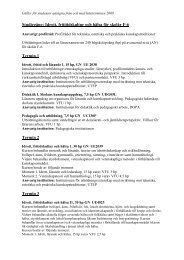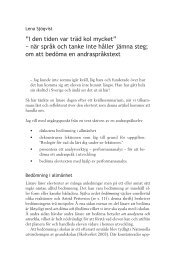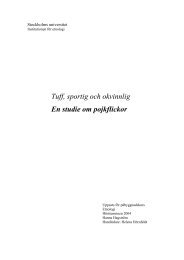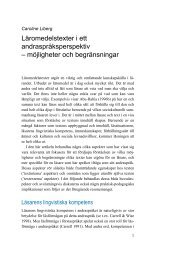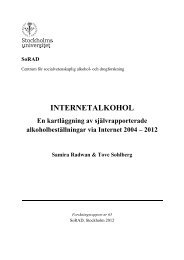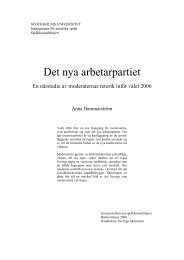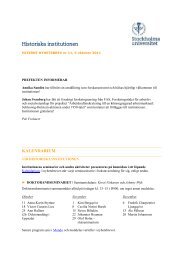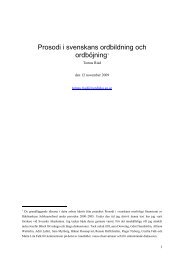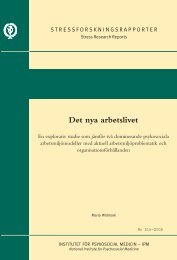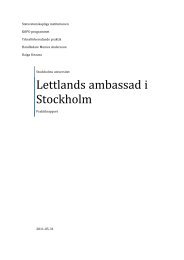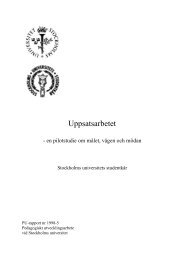Plants and Ecology 2009:7 - Stockholms universitet
Plants and Ecology 2009:7 - Stockholms universitet
Plants and Ecology 2009:7 - Stockholms universitet
Create successful ePaper yourself
Turn your PDF publications into a flip-book with our unique Google optimized e-Paper software.
Sympatric speciation in Baltic Sea<br />
Fucus populations<br />
Is vegetative reproduction the key for evolution of F. radicans ?<br />
by<br />
Dan Tiderman<br />
<strong>Plants</strong> & <strong>Ecology</strong><br />
Plant <strong>Ecology</strong> <strong>2009</strong>/7<br />
Department of Botany<br />
Stockholm University
Sympatric speciation in Baltic Sea<br />
Fucus populations<br />
Is vegetative reproduction the key for evolution of F. radicans ?<br />
by<br />
Dan Tiderman<br />
Supervisors:<br />
Helena Forslund <strong>and</strong> Lena Kautsky<br />
<strong>Plants</strong> & <strong>Ecology</strong><br />
Plant <strong>Ecology</strong> <strong>2009</strong>/7<br />
Department of Botany<br />
Stockholm University
<strong>Plants</strong> & <strong>Ecology</strong><br />
Plant <strong>Ecology</strong><br />
Department of Botany<br />
Stockholm University<br />
S-106 91 Stockholm<br />
Sweden<br />
© Plant <strong>Ecology</strong><br />
ISSN 1651-9248<br />
Printed by Solna Printcenter<br />
Cover: Adventitious branch from Fucus radicans. Photo by Dan Tiderman.
Summary<br />
Speciation processes are a disputed area of research, <strong>and</strong> subjected to constant review <strong>and</strong><br />
adjustment. The theories of allopatric speciation that are focusing on isolation mechanisms as<br />
the dominating force for speciation have been regarded as the main path for speciation, but<br />
have recently been challenged by several studies indicating different modes of sympatric<br />
speciation. Few of these studies have concerned plants, but a recent identification of the Baltic<br />
Sea seaweed Fucus radicans have highlighted a situation of probable sympatric speciation<br />
under some intricate circumstances. The complex history <strong>and</strong> environment of the brackish<br />
Baltic Sea area, <strong>and</strong> the predominant vegetative reproduction strategy of Swedish F. radicans<br />
raises several questions. The evolutionary forces present while F. radicans arguably split<br />
from the sympatric populations of Fucus vesiculosus seems ambiguous in several ways <strong>and</strong><br />
the evolutionary history is difficult to access. To improve the insight of the domain, a<br />
comparative test of Swedish F. radicans abilities for vegetative reproduction was performed<br />
with the aim to possibly find the forces trigging the emergence of F. radicans <strong>and</strong> the factors<br />
restricting the current spatial occurrence of this species. Adventitious branches from four<br />
different categories of origin/species from Swedish <strong>and</strong> Estonian F. vesiculosus <strong>and</strong> F.<br />
radicans respectively were compared in a controlled experimental setup to evaluate possible<br />
adaptations towards vegetative reproduction.<br />
The results indicate that the vegetatively reproducing Swedish F. radicans have adapted to<br />
develop more extensive branching <strong>and</strong> some other morphological traits possibly linked to<br />
nutrient uptake. The observed differences in morphology, the vegetative reproduction<br />
strategy, <strong>and</strong> the adaptations revealed in this study are proposed to be linked to the northern<br />
boundary of the fundamental niche of these two closely related Fucus species, where the low<br />
salinity environment probably is restricting the success of sexual reproduction. However,<br />
other factors than the reproductive strategy could as well have been triggering the emergence<br />
of F. radicans. When trying to explain the evolutionary history of F. radicans several<br />
scenarios such as polyploidy or relict populations may be suggested as the source for the<br />
emergence of F. radicans in the Baltic Sea. Those are briefly presented <strong>and</strong> discussed as<br />
alternative explanations, but the complexity of the ecologically related adaptations needs<br />
further both genetic <strong>and</strong> ecological studies.<br />
3
Sammanfattning<br />
Artbildningsprocesser är ett omtvistat forskningsområde som ständigt är föremål för<br />
uppdateringar och justeringar. De alloptriska artbildningsteorierna som grundar sig på teorier<br />
om att olika former av isolering mellan populationer är den avgör<strong>and</strong>e faktorn för artbildning<br />
har länge varit dominer<strong>and</strong>e. Men de har på senare tid utmanats av studier som påvisat olika<br />
typer av sympatrisk artbildning. Få av dessa studier har emellertid baserats på växtstudier,<br />
men en nyligen identifierad tångart i Östersjön har lyft fram ett fall av trolig sympatrisk<br />
artbildning under något speciella förhåll<strong>and</strong>en. Den komplicerade evolutionära historien och<br />
miljön i Östersjöns brackvattenmiljö, samt den huvudsakligen vegetativa<br />
reproduktionsstrategin hos de svenska populationerna av den nyligen identifierade arten<br />
Fucus radicans, lyfter fram ett flertal frågeställningar. De evolutionära drivkrafterna som<br />
verkat då F. radicans förmodat uppstått ur Fucus vesiculosus kan uppfattas som mångtydiga<br />
på många sätt och den evolutionära utvecklingen är svår att överblicka. För att skapa mer<br />
förståelse inom området, gjordes en jämför<strong>and</strong>e studie av svensk F. radicans förmåga till<br />
vegetativ förökning med syftet att om möjligt belysa de drivkrafter som legat bakom<br />
uppkomsten av F. radicans samt vilka faktorer som reglerar artens nuvar<strong>and</strong>e utbredning.<br />
Adventivgrenar från fyra kategorier av art/ursprung med svensk och estnisk F. radicans<br />
respektive F. vesiculosus jämfördes i en kontrollerad försöksmiljö för att utvärdera möjliga<br />
anpassningar mot vegetativ reproduktion.<br />
Resultaten påvisar att den vegetativt reproducer<strong>and</strong>e svenska F. radicans har anpassat sig<br />
genom ett mer förgrenat växtsätt samt <strong>and</strong>ra morphologiska egenskaper som möjligen är<br />
förknippade med näringsupptag. De observerade morfologiska skillnaderna, den vegetativa<br />
reproduktionsstrategin och anpassningarna som påvisas i denna studie föreslås vara kopplade<br />
till den nordliga utbredningsgränsen för de två nära besläktade Fucus arterna där den låga<br />
salthalten förmodligen begränsar framgången av sexuell förökning. Det kan emellertid finnas<br />
fler orsaker än reproduktionsstrategier som legat bakom uppkomsten av F. radicans i<br />
Östersjön. Dessa alternativa förklaringar är översiktligt presenterade och diskuterade.<br />
Komplexiteten av dessa ekologiskt betingade anpassningar visar på behov av fler studier,<br />
både inom de genetiska och ekologiska forskningsområdena.<br />
4
Introduction<br />
The emergence of new species were long exclusively regarded as the result of genetic drift in<br />
subpopulations separated by some kind of geographic barrier, <strong>and</strong> the resulting differentiated<br />
populations where commonly classified as separate species if reproductive isolation had<br />
occurred (Mayr 1963; Dobhansky 1970). The definition of species were later on suggested to<br />
comprise populations with uniting attributes such as reproductive period, anatomy <strong>and</strong><br />
reproductive behaviour (Templeton 1989; Paterson 1985). This definition included vegetative<br />
reproducing species which were not considered by the definition of reproductive isolation.<br />
Another view of the species concept is the phylogenetic approach (Cracraft 1983), where<br />
species are regarded as populations with a common ancestor <strong>and</strong> with some new characters<br />
possible to diagnose. Most of these species theories are compromised in that they do not<br />
account for the ever present <strong>and</strong> ambiguous processes of hybridisation <strong>and</strong> the situation of<br />
constant ongoing evolutionary processes. This is still an uncomfortable vagueness in the<br />
speciation concepts <strong>and</strong> was remarked by Buffon already in the 1800 th century (Sörman<br />
2007).<br />
Using a simplified spatial approach, speciation can be separated in to allopatric speciation<br />
where isolation factors are the keys <strong>and</strong> into sympatric speciation, where speciation occurs<br />
without any apparent isolation between populations. The traditional, <strong>and</strong> still largely<br />
dominating speciation theories that are based on reproductive isolation all fall into the<br />
category of allopatric speciation where the antagonistic forces of spatially dependent<br />
adaptation <strong>and</strong> gene flow makes up the key mechanism of the evolutionary process. The<br />
sympatric speciation theory is more recent <strong>and</strong> suggests that in some circumstances speciation<br />
can occur in populations without the presence of separating barriers, typically in recently<br />
colonized or isolated areas that offer a variety of new niches (Schliewen et al. 2001). An<br />
important mechanism in plants but also known in some animals, are speciation by polyploidy,<br />
where characters can change in relative short periods by chromosome multiplication.<br />
Polyploidy is also suggested to be one of the predominant modes of sympatric speciation in<br />
plants due to the large effects on gene regulation (Otto & Whitton 2000).<br />
Several studies have demonstrated sympatric speciation <strong>and</strong> some examples are:<br />
differentiating to host plant adaptation in flies (Feder et al. 1988), adaptation to different<br />
patterns for sexual selection in African cichlids (Schliewen et al. 2001), <strong>and</strong> adaptive niche<br />
separation in salmons (Lu & Bernatchez 1999). In plants, however some of these adaptive<br />
5
forces do not seem applicable due to the sessile life strategies in plants which inhibit active<br />
choosing among patchy micro niches <strong>and</strong> are excluding the impact from active mating.<br />
However recent studies indicates that sympatric speciation has occurred in the Baltic Sea<br />
seaweed, Fucus radicans (L. Bergström et L. Kautsky sp. nov.). The species has arguably<br />
descended from Fucus vesiculosus (L.) (Pereyra et al. <strong>2009</strong>) <strong>and</strong> has recently attracted<br />
attention, as new research has revealed that this dwarf morph is to be regarded as a species of<br />
its own (Bergström et al. 2005).<br />
The scene of this sympatric speciation, the Baltic Sea, is the largest brackish water body in the<br />
world <strong>and</strong> is intriguing as a scene for speciation processes for several reasons. The<br />
longitudinal extension makes for a varying range of climatic environments. The restricted<br />
influx of marine water to the southwest in conjunction with abundant freshwater supplies<br />
from the northern parts results in a consecutive salinity gradient increasing southwards. The<br />
young <strong>and</strong> complex evolutionary history of approximately 8000 years since the last<br />
glaciations (Björk 1995) entails a flora <strong>and</strong> fauna in transformation (Kautsky et al. 1992;<br />
Johannesson & André 2006). The brackish environment generally present a challenging<br />
environment, optimal neither for organisms from marine or freshwater origin. The<br />
composition of the inhabitants today (Sommer et al. 2008; Schmölke 2008) indicates that the<br />
majority of the current marine species immigrated during the marine Littorina Sea period. The<br />
marine organisms in the area have since then been going through an intensive adaptation <strong>and</strong><br />
extinction phase (Johannesson & André 2006) in a sequence of successive transformation of<br />
the environment towards freshwater conditions.<br />
The fucoids F. radicans <strong>and</strong> F. vesiculosus are the only structural large, long-lived macroalgal<br />
species in the Bothnian Sea where they form the canopy along bedrock <strong>and</strong> gravel shores<br />
making an important foundation for the ecological communities present (Wikström &<br />
Kautsky 2007, Kautsky et al. 1992). Fucus radicans have been found in the Bothnian Sea, <strong>and</strong><br />
along the Estonian coast (Bergström et al. 2005; Pereyra et al. <strong>2009</strong>). Findings of the species<br />
in the Gulf of Finl<strong>and</strong> are difficult to assess due to uncertainties regarding the wide range of<br />
morphological variance found, which is not yet genetically resolved. Just like F. vesiculosus<br />
the Estonian populations of F. radicans are sexually reproducing. Contrary to this, the F.<br />
radicans populations in the Bothnian Sea are predominantly reproducing vegetatively<br />
(Bergström et al. 2005; Tatarenkov et al. 2005) growing adventitious branches that fall off to<br />
generate new clonal individuals (Tatarenkov et al. 2005). This situation of regional vegetative<br />
6
eproduction may cause low genetic variation <strong>and</strong> may consequently lead towards long term<br />
restriction in adaption capabilities. This could possibly make the clonal populations<br />
vulnerable to long term changes in the environment (Spielman et al. 2004).<br />
The situation of an apparent sympatric speciation into the current clonal populations raises<br />
several questions. Why <strong>and</strong> how did the speciation occur <strong>and</strong> why are clonal F. radicans<br />
populations successful in the Bothnian Sea <strong>and</strong> especially in the northern parts where studies<br />
indicate that it is relatively more abundant (Forslund <strong>2009</strong>a). Could the vegetative<br />
reproduction actually be the key for the emergence of F. radicans ? One possible explanation<br />
is that vegetative reproduction is more effective due to the limited efficiency of sexual<br />
reproduction in low salinity environments, where osmosis mechanisms restrict the success<br />
<strong>and</strong> survival of the eggs released (Serrão et al. 1996; Serrão et al. 1999). This could possibly<br />
explain why the vegetatively reproducing F. radicans has evolved in this area, at the margin<br />
of the fundamental niche for fucoids. Also, other factors in these marginal areas could be of<br />
importance as environmental stress factors probably are restricting F. vesiculosus in more<br />
ways than just reproduction, thus possibly relieving some of the overall competitive pressure<br />
for F. radicans (Johannesson & André 2006).<br />
One prerequisite for F. radicans to be superior to F. vesiculosus regarding vegetative repro-<br />
duction is that some new traits enhancing this reproduction strategy have been acquired. I<br />
tested the hypothesis that clonal Fucus populations should use more resources for vegetative<br />
reproduction than sexually reproducing Fucus populations by counting the number of advent-<br />
tious branches per biomass in plants of both F. vesiculosus <strong>and</strong> F. radicans from two regions.<br />
The extent, <strong>and</strong> establishment of released adventitious branches are hypothesised to be more<br />
critical to F. radicans with a reduced ability to establish by sexually produced zygotes. In the<br />
sexually reproducing populations, adventitious branches could possibly serve primary as free<br />
floating individuals improving the ability for long range spreading (Ingólfsson 1995) <strong>and</strong> thus<br />
be assumed to be of less importance. I tested the establishment ability of adventitious<br />
branches by growing adventitious branches from Estonian <strong>and</strong> Swedish F. radicans <strong>and</strong> F.<br />
vesiculosus respectively on a substrate while examining the extent of rhizoid development <strong>and</strong><br />
comparing the ability to adhere to the substrate.<br />
7
The following hypothesis where also defined: Adventitious branches from F. radicans have<br />
more cryptostomata than does F. vesiculosus. The rationale for this is that the narrower thallus<br />
in F. radicans (Bergström et al. 2005) allows for less nutrient uptake, which should be<br />
compensated by a higher density of cryptostomata provided with hyaline hairs possibly<br />
serving as a exp<strong>and</strong>ed surface for nutrient uptake (Deboer & Whoriskey 1983). This was<br />
tested by counting the cryptostomata in adventitious branches from the two species, grown in<br />
the same environmental conditions.<br />
Material & Methods<br />
Study species<br />
The macroalgae F. radicans, <strong>and</strong> F. vesiculosus are two of the three known fucoids in the<br />
Baltic Sea. They are both canopy forming in shallow waters <strong>and</strong> on hard substrate bottoms.<br />
As all fucoids they are perennial <strong>and</strong> produce one type of diploid thallus.<br />
Fucus radicans differs from F. vesiculosus morphologically in having a more shrubbery<br />
appearance, being smaller in size <strong>and</strong> slimmer in the dimensions. It also lacks the vesicles<br />
present in F. vesiculosus. Though being dioecious as is F. vesiculosus, the Bothnian Sea<br />
populations of F. radicans is predominantly vegetative reproducing (Tatarenkov et al. 2005),<br />
while the Estonian populations of F. radicans seems to reproduce predominantly sexually like<br />
F. vesiculosus (H. Forslund pers. comm.). The adventitious branches growing from the thallus<br />
are the main source for vegetative reproduction in both F. radicans <strong>and</strong> F. vesiculosus. These<br />
branches can remain on the thallus extending the branching or detach to serve as propagules<br />
for new individuals. If the rhizoids originating from the base of the adventitious branches,<br />
find a suitable substratum, the branch has the possibility to attach <strong>and</strong> establish a new sessile<br />
plant (Tatarenkov et al. 2005).<br />
Study sites <strong>and</strong> sampling<br />
Individuals from four different combinations of population sites <strong>and</strong> species where used for<br />
the study. Swedish <strong>and</strong> Estonian F. radicans <strong>and</strong> Swedish <strong>and</strong> Estonian F. vesiculosus. The<br />
Swedish individuals of both F. radicans <strong>and</strong> F. vesiculosus where collected in Öregrund the<br />
24 th of April <strong>and</strong> the Estonian plants at Ösel on the 1 st of Maj. The plants where transported in<br />
cool <strong>and</strong> humid conditions <strong>and</strong> placed in tanks after 1-2 days <strong>and</strong> subsequently accommodated<br />
on the bottom of shallow water open cisterns for a period of 7-8 weeks at the Askö marine<br />
laboratory. The cisterns where supplied by continuous incoming sea water with an<br />
approximate temperature of 14ºC <strong>and</strong> 6.5 ‰ salinity <strong>and</strong> natural light. From each of the<br />
8
site/species combinations, 10 plants <strong>and</strong> a couple of reserve plants where r<strong>and</strong>omly picked. It<br />
should be noted that in collecting the Estonian samples of F. vesiculosus some plants where<br />
short in adventitious branches. In these cases a new plant where r<strong>and</strong>omly choosen. Also<br />
notably is that the Estonian samples of F. vesiculosus by visual impression where in slightly<br />
worse condition than the other categories sampled. The number of adventitious branches for<br />
each plant where counted <strong>and</strong> the plants where weighted wet after surplus water was removed.<br />
Ten adventitious branches of 2-5mm in size were detached from each sample plant <strong>and</strong><br />
located on granite discs of 35mm diameter. The discs were encircled by a cylindrical mesh net<br />
of 40mm height attached to the discs perimeter by aquarium silicone. The net served as a<br />
restricting barrier in case of turbulence or accidental movements of the samples. The samples<br />
were placed in a temperature of 15ºC inside oblong plastic containers of approximately 80<br />
liter <strong>and</strong> a water depth of 75mm. The system was continuously fed by sea water in an<br />
approximately rate of 30 l/h with a temperature of 14ºC. The sample discs where r<strong>and</strong>omly<br />
orientated 35 mm below the surface in the drain end of the container. The water were mixed<br />
by air feeding stones in the tap end of the container causing slight surface undulations in the<br />
drain end. Illumination of 3200 Kelvin color temperature were present for 18 hours/day with<br />
an intensity of 87 µmol s - ¹ m² at surface level. Gentle cleaning of the mesh net were executed<br />
at an interval of 4 weeks approximately. After 11 weeks the adventitious branch samples were<br />
examined visually using magnification equipment. The observations made were: occurrence<br />
of rhizoids, if rhizoids where attaching to the disc, the amount of growth <strong>and</strong> the cross section<br />
shape of the thallus, if cryptostomata were present <strong>and</strong> the amount observed. The observations<br />
were either boolean or ordered classifications based on definitions as follows:<br />
Definitions <strong>and</strong> classification for observations:<br />
Occurrence of rhizoids – rhizoids visible or not visible<br />
Rhizoids attached to the substrate – The base of the branch steadily attached by rhizoids <strong>and</strong> not detached by<br />
a slightly movement of the branch in the upper part.<br />
The amount of growth –<br />
No apparent growth<br />
Limited growth, less than or equal to 50%<br />
Substantial growth, more than 50%<br />
Cross section shape of main body –<br />
Circular: width less or equal to 2x the height<br />
Elliptical: width more than 2x, but less or equal to 3x the height<br />
Flattened: width more than 3x the height<br />
Amount of cryptostomata –<br />
No/few: Not visible or less than 4<br />
Normal :4 or more<br />
9
Statistical analyses of the number of adventitious branches were made using one-way<br />
ANOVA. Occurrence of rhizoid <strong>and</strong> cryptostomata were analysed by Fisher's Exact Test <strong>and</strong><br />
the growth <strong>and</strong> cross section shape were analyzed by chi-square methods. All analyses were<br />
made using R version 2.9.0 (R Development Core Team <strong>2009</strong>).<br />
Results<br />
Number of adventitious branches<br />
The vegetative reproducing Swedish F. radicans had significantly more adventitious branches<br />
than the sexually producing categories (F4, 45 = 86.26, p < 0.001,). Swedish F. vesiculosus also<br />
showed significant more branches than the Estonian counterpart. (F4, 45 = 86.26, p < 0.01).<br />
Figure 1<br />
Number of adventitious branches per g measured wet weight in plants from the<br />
four combinations of species/origin. Error bars show confidence interval (n= 10)<br />
10
Rhizoid development by the adventitious branches<br />
Very few of the adventitious branches developed rhizoids. The results showed no differences<br />
between categories (p = 0.34). Only 7 of the total number of branches used(450) where firmly<br />
attached to the platter.<br />
Figure 2<br />
The percentage of adventitious branches that developed rhizoids showed no significant<br />
differencies between the origin/species combinations [ n = 100(Swedish F. radicans);<br />
120(Estonian F. radicans); 120(Swedish F. vesiculosus); 110(Estonian F. vesiculosus) ]<br />
11
The overall thallus growth <strong>and</strong> the cross section shape<br />
The Estonian F. radicans had the highest general growth rate with 88% having substantial<br />
growth, (χ² = 120.6; df=6; p
The amount of Cryptostomata<br />
Although F. vesiculosus developed less cryptostomata overall than did F. radicans, different<br />
patterns were found depending on the origin. In Sweden F. vesiculosus had more<br />
cryptostomata than F. radicans (p < 0.01) but in Estonia the species-cryptostomata relation<br />
was reversed (Fig. 5).<br />
Figure 5<br />
The results indicate that F. radicans in Estonia had slightly more samples with a<br />
higher amount of cryptostomata compared to the F. vesiculosus populations, but<br />
with the opposite relation found in the populations originating from Sweden<br />
(n=100,120,120,110 respectively)<br />
13
Discussion<br />
The results from this study shows that the vegetative reproducing Swedish F. radicans had<br />
significantly more adventitious branches than the predominantly sexually reproducing<br />
populations of F. vesiculosus <strong>and</strong> the F. radicans population originating from Estonia. In line<br />
with the hypothesis stipulated, this could indicate that Swedish F. radicans are allocating<br />
more resources into producing vegetative propagules for new individuals instead of investing<br />
efforts in producing sexual gametes. This could imply that the extent of branch development<br />
in Swedish F. radicans may be a result of adaption towards an amount of branch development<br />
that brings a reproductive advantage in the special circumstances of the Bothnian Sea.<br />
Presuming that the majority of adventitious branches produced are not departed from the<br />
source plant <strong>and</strong> thus brings a more shrubby morphological overall appearance, a second<br />
interpretation of the results is possible. Traits such as extensive branching could potentially be<br />
an advantage in the prevailing conditions by extending the surface area for nutrient uptake<br />
while still keeping an overall size. The more compact morphology could make the plant less<br />
vulnerable to external factors like ice scouring or limitations in nutrient resources. The<br />
extended nutrient uptake capabilities could also imply that the improved vegetative repro-<br />
ductive abilities could be a secondary effect <strong>and</strong> may be the result of an initial morphological<br />
adaption towards extended surface area. Whether or not any of these adaptive forces were<br />
initially driving the adaption towards a more extensive branching is not clear, but the advan-<br />
tages from both of these consequences may be crucial for the fitness of Swedish F. radicans.<br />
One question arising when analysing the amounts of branching is if the morphological<br />
differences are a case of adaption or plasticity. In the case of the two F. radicans populations,<br />
plasticity could not be excluded due to the fact that the spatially split populations initially had<br />
different environmental conditions, even if the recent environment have been the same. This<br />
would however imply that the plasticity is a trait unique for F. radicans because I) the results<br />
comparing the two different sympatric Fucus species from the Swedish coast also show clear<br />
difference in the amount of branching, II) the spatially split F. vesiculosus population does not<br />
show the same obvious difference in branching as the F. radicans populations.<br />
The test of rhizoid development under artificial conditions showed less overall growth of<br />
rhizoids than expected <strong>and</strong> no species/origin combination produced more rhizoids than the<br />
others. As shown by the results the overall growth of the adventitious branches were not low<br />
in general. This signs of a basically sound environmental living conditions should<br />
14
consequently rule out the environment to be the cause for the generally meagre rhizoid<br />
development <strong>and</strong> leads to the suspicion that some key environmental factors controlling<br />
rhizoid growth have been poorly understood, <strong>and</strong> that the trigger inducing rhizoid<br />
development is still to be found. A previous studie (Tatarenkov et al. 2005) has shown<br />
significant differences between the rhizoid development in F. radicans <strong>and</strong> F. vesiculosus <strong>and</strong><br />
a more extensive rhizoid development overall. If further studies are to be performed,<br />
preparatory work is needed to examine the environmental factors trigging the growth of<br />
rhizoids, provided such factors are to be found. The success rate of vegetative propagules in<br />
natural conditions is another issue of interest for underst<strong>and</strong>ing the dynamics of the<br />
evolutionary pathways, this is an area largely yet to be investigated.<br />
To try to answer the question if the vegetative reproduction is the key to the emergence of<br />
sympatric Fucus populations in the Bothnian Sea, it is appropriate to monitor alternative<br />
reasons for the current spatial presence of F. radicans. That is, what are F. radicans merits in<br />
this particular environment compared to its larger sibling species F. vesiculosus? If no<br />
restricting environmental factors are present it is generally a good idea to maximize the<br />
available resources <strong>and</strong> grow big, as this will enhance the competitive ability in several ways,<br />
as for example suppression of competition or greater reproductive ability. On the other h<strong>and</strong> if<br />
resources become sparser, predation increases, different forms of environmental stress factors<br />
are present, a bigger body may not be the best solution <strong>and</strong> could possibly backlash due to<br />
difficulties at maintaining the more abundant biomass <strong>and</strong> coping with temporary harsher<br />
conditions. This generally mean that for F. radicans there may be more benefits than<br />
reproductive advantage alone to favor the species in the northern Bothnia Sea which is<br />
constituting one of the margins of the fundamental niche for Fucus species. Some<br />
environmental factors for further studies are the physiological impact of regional variations in<br />
seasonal salinity due to river outwash in the north, or the consequences from ice scouring <strong>and</strong><br />
the effects of the more extended periods of permanent sea ice in the north.<br />
A puzzling situation is the presence of F. radicans in Estonia. In this area where F. radicans<br />
reproduces sexually the benefits of vegetative reproduction or the possible impact of stress<br />
factors areas are not that obvious. One possible reason for the presence here (L. Kautsky pers.<br />
comm.) is that the sea bed is constituted by coarse gravel over finer sediments. This may be<br />
prohibiting the larger F. vesiculosus from reaching reproductive size. The cause for this could<br />
be that plants of greater size, as F. vesiculosus, established on the relative fine sized gravel is<br />
15
easier moved away by currents or wave action. This is then possibly a lesser problem for the<br />
more slender built F. radicans.<br />
Comparing the two Estonian Fucus species, F. radicans had slightly more cryptostomata than<br />
F. vesiculosus. With the former species having a relatively slimmer thallus cross section,<br />
more cryptostomata <strong>and</strong> thus more hyaline hairs for nutrient uptake could be a way of<br />
compensating for the relative lesser thallus surface area. However it should be noted that the<br />
greater amount of cryptostomata in this study could be an effect of the overall greater growth<br />
noted in the Estonian F. vesiculosus samples. There could also be a lesser need for surface<br />
area in F. radicans due to the geometric laws stating that a smaller body possesses a greater<br />
surface area to volume quota. Contrary to the Estonian populations the Swedish F. radicans<br />
showed less cryptostomata than the Swedish F. vesiculosus. This is opposing the nutrient<br />
theory proposed for the Estonian populations but could be a logic consequence of the<br />
comparably more shrubby appearance <strong>and</strong> more extensive branching in Swedish F. radicans<br />
compared to the Estonian counterpart. This shrubbiness could serve as an alternative mean of<br />
extending the surface area.<br />
Then why do not the Swedish populations use the same strategy with more cryptostomata as<br />
the Estonian populations? The reasons could be twofold. Firstly the branching could serve a<br />
vital secondary purpose as extended capacity for vegetative reproduction in the northern low<br />
salinity environment generally hampering sexual reproduction ( Serrão et al. 1996; Serrão et<br />
al. 1999). Secondary, it could be a way of improving the durability against herbivores by<br />
minimizing the hyaline hairs otherwise needed <strong>and</strong> possibly attractive for herbivores. The<br />
latter would also be in line with the proposal by Forslund (<strong>2009</strong>b) that Swedish F. radicans<br />
has lower levels of chemical defense than F. vesiculosus which consequently could imply that<br />
F. radicans are more vulnerable to herbivores. By concatenating the results from this study<br />
<strong>and</strong> the previous discussion of evolutionary forces, a web can be constructed illustrating the<br />
suggested interacting factors <strong>and</strong> thus possibly explaining the spatial occurrence of Fucus<br />
radicans in the Baltic Sea (Fig 6). In comparing the ability for nutrient uptake in F. radicans<br />
to sympatric populations of F. vesiculosus, it is possible to propose that F. radicans could be<br />
using an alternative strategy for extending the surface area. This strategy may be well suited<br />
to the Bothnian Gulf with implications for reproductive success in the north <strong>and</strong> to herbivore<br />
defense abilities in the south thus delimiting the population to the current spatial range.<br />
16
Figure 6<br />
Comparing the ability for nutrient uptake in F. radicans to sympatric populations of F. vesiculosus with<br />
the Estonian population to the right <strong>and</strong> the Swedish to the left, the ability of F. vesiculosus are used<br />
as a reference level on the line indicating the necessary level of nutrient uptake ability. Divergent<br />
abilities from this norm is represented by arrows indicating traits that are positive(up) or<br />
negative(down). Attached are miniatures of the results from this study, supporting the claims for the<br />
deviations in nutrient uptake ability. To the far left are some proposed derived consequences of the<br />
nutrient deviations influencing the spatial occurrence of the Swedish F. radicans. These traits are<br />
suggested to have implications for reproductive success in the north <strong>and</strong> to herbivore defense abilities<br />
in the south thus limiting the population to the current spatial range.<br />
In contemplating some scenarios describing the sympatric speciation process <strong>and</strong> especially<br />
emphasizing the impact from the vegetative reproduction strategy used by Swedish F.<br />
radicans, it is probable that a few clonal individuals of F. radicans have succeeded in<br />
populating vast spatial areas (Tatarenkov et al. 2005). This could have been made possible<br />
through exploiting this alternative reproduction strategy <strong>and</strong> by doing so tweaking the rules of<br />
speciation. This alternative path is realized by effectively displacing sexual reproduction as<br />
the common framework for the speciation processes <strong>and</strong> thus minimizing the counteracting<br />
forces of hybridization. Maybe these resulting populations are to be regarded as a transitional<br />
form in a temporary abnormal evolutionary situation, with clonal individuals exploiting a<br />
temporary marginal environment to make improved clonal abilities to prosper in a timeframe<br />
17
of limited endurance. The longevity of the genetically restricted populations of clonal F.<br />
radicans will ultimately give the answer.<br />
Even if we are witnessing a turmoil of ongoing speciation processes beginning after the<br />
deglaciation about 8000 years ago, it would be extraordinary to imagine a rapid speciation<br />
with these type of adaption’s realized in a very short time space, even as short as 400 years as<br />
proposed in models by Pereyra et al.(2008) based on microsatellite markers. The parallels to<br />
this would be few worldwide <strong>and</strong> the tendency for F. radicans populations to emerge in some<br />
different areas of the Baltic Sea under slightly different environmental conditions showing<br />
such minor morphological differences is amazing. Although somewhat improbable there is a<br />
possibility that convergent evolution has occurred in the geographically separated areas of the<br />
Bothnian Sea <strong>and</strong> of Ösel. Somewhat more probable is an initial evolution in one area <strong>and</strong><br />
subsequent spreading <strong>and</strong> readapting into another. Maybe clonality in the Swedish/Finnish<br />
population is such a secondary trait recently emerging. The high heterozygosity found among<br />
clonal populations (Johanson 2008) could support this. If this trait of clonality commonly<br />
known in marginal areas is indeed a recent evolution we can expect further loss of sexual<br />
reproductive abilities in the future, based on indications that environmental suppression of<br />
sexual recruitment may lead towards sterility (Eckert 2002). Provided these populations of F.<br />
radicans emerged suddenly <strong>and</strong> maybe even separately, some traits already inherent may<br />
suddenly have prospered perhaps due to a change in the environmental conditions. One<br />
possibility is that a suppressed relict population of F. radicans has been present in the Baltic<br />
Sea. Another possible scenario supported by the fast <strong>and</strong> simultaneous evolution of the F.<br />
radicans populations <strong>and</strong> the morphologic relationship between F. vesiculosus <strong>and</strong> F.<br />
radicans is polyploidy. If a species resembling F. radicans once was the now extinct ancestor<br />
to the current F. vesiculosus we could maybe be witnessing a retreat from polyploidy<br />
triggered by the prevailing environmental conditions. Regardless the specific history, the<br />
evolutionary history of F. radicans is probably a scenario consisting of a mix of punctuated<br />
equilibrium phases <strong>and</strong> intermediate gradualism where the former pattern have been realized<br />
through evolutionary opportunism in situations of sudden environmental changes.<br />
18
To conclude the experiences from this study, several adaptations of possible importance are<br />
found in the Swedish populations of F. radicans. These adaptations are: the more extensive<br />
branching, the vegetative reproduction, the possibly adapted levels of cryptostomata, <strong>and</strong> the<br />
morphological traits general to F. radicans. It would probably be unwise to view these<br />
adaptions as singular individual traits, but instead as a web of intricate combined <strong>and</strong><br />
coordinated adaptations resulting in populations well suited to the very special marginal<br />
environment of the Bothnian Sea. It is not obvious that vegetative reproduction ability is the<br />
key for the evolution of Fucus radicans, but regardless of whether the clonality was an<br />
original trait <strong>and</strong> a key for the speciation to occur, or was a secondary adaption <strong>and</strong> maybe<br />
ultimately an evolutionary dead end, it is very likely to have been of great importance for the<br />
species present success in the Bothnian Sea.<br />
Acknowledgements<br />
Many thanks for the general support to the Plant <strong>Ecology</strong> people in the department of Botany<br />
at the University of Stockholm. Also thanks to the staff at the Askö Marine Laboratories for<br />
facilitating the practical parts of this work. Very special thanks to my supervisors Helena<br />
Forslund <strong>and</strong> Lena Kautsky for sharing their knowledge <strong>and</strong> supporting me with invaluable<br />
guidance <strong>and</strong> advice.<br />
19
References<br />
Bergström, L., Tatarenkov, A., Johannesson, K., Jönsson, R.B. & Kautsky, L. (2005) Genetic<br />
<strong>and</strong> morphological identification of Fucus radicans sp Nov (Fucales, Phaeophyceae) in the<br />
brackish Baltic Sea - Journal of Phycology 41:1025-1038.<br />
Björk, S. (1995) A review of the history of the Baltic Sea, 13.0 -8.0 ka BP 1995 –<br />
Quarternary International 27:19-40.<br />
Cracraft, J. (1983) Species concepts <strong>and</strong> speciation analysis. - Current Ornithology 1:159-<br />
187.<br />
DeBoer, J.A. & Whoriskey, F. G. (1983) Production <strong>and</strong> role of hyaline hairs in Ceramium<br />
rubrum. - Marine Biology 77:229-234.<br />
Dobhansky, T. (1970) Patterns of Species Formation, Genetics of the Evolutionary Process.<br />
Columbia University Press, New York.<br />
Eckert, C. G. (2002) The loss of sex in clonal plants. Evolutionary <strong>Ecology</strong> 15:501-520<br />
Feder, J. L., Chilcote C. A.& Bush, G. L., (1988) Genetic differentiation between sympatric<br />
host races of Rhagoletis pomonella. - Nature 366:61-64.<br />
Forslund, H. (<strong>2009</strong>a) Grazing <strong>and</strong> the geographic range of the recently described Fucus<br />
radicans (Phaeopyceae). – <strong>Plants</strong> & <strong>Ecology</strong> 5:II.<br />
Forslund, H. (<strong>2009</strong>b) Grazing <strong>and</strong> the geographic range of seaweeds, The introduced Fucus<br />
evanescens <strong>and</strong> the newly described Fucus radicans. – <strong>Plants</strong> & <strong>Ecology</strong> 5.<br />
Ingólfsson, A. (1995) Floating clumps of seaweed around Icel<strong>and</strong>: natural microcosms <strong>and</strong> a<br />
means of dispersal for shore fauna. – Marine Biology 122:13-21.<br />
Johansson, D. (2008) Genetic variation is maintained in populations with low clonal diversity.<br />
Master Thesis in Marine <strong>Ecology</strong>, Dep. Of Marine <strong>Ecology</strong>, University of Gothenburg<br />
Johannesson, K. & André, C. (2006) Life on the margin: genetic isolation <strong>and</strong> diversity loss in<br />
a peripheral marine ecosystem, the Baltic Sea. – Molecular <strong>Ecology</strong> 15:2013-2029.<br />
Kautsky, H., Kautsky, L., Kautsky, N., Kautsky, U., & Lindblad, C. (1992) Studies on the<br />
Fucus vesiculosus community in the Baltic Sea – Acta Phytogeogr. Suec. 78, Uppsala ISBN<br />
91-7210-078-8.<br />
Lu, G., Bernatchez, L. (1999) Correlated Trophic Specialization <strong>and</strong> Genetic Divergence in<br />
Sympatric Lake Whitefish Ecotypes - Evolution 53:1491-1505<br />
Mayr, E. (1963) Animal Species <strong>and</strong> Evolution. Harvard University Press. Cambridge.<br />
Otto, S. P. & Whitton, J. (2000) Polyploid incidence <strong>and</strong> evolution. – Annual Review of<br />
genetics 34: 401-437.<br />
20
Paterson, H.E.H. (1985) The recognition concept of species. In Vrba, E. S. (eds.) Species <strong>and</strong><br />
speciation. Transvaal Museum Monograph No. 4, Pretoria, pp 21-29.<br />
Pereyra, R. T., Bergström, L., Kautsky, L. & Johannesson, K. (<strong>2009</strong>) Rapid speciation in a<br />
newley opened postglacial marine environment, the Baltic Sea. – BMC Evolutionary Biology<br />
9:7.<br />
R Development Core Team (<strong>2009</strong>) R: A language <strong>and</strong> environment for statistical computing.<br />
R Foundation for Statistical Computing, Vienna, Austria. ISBN 3-900051-07-0, URL<br />
http://www.R-project.org.<br />
Schliewen, U., Rassmann, K., Markmann, M., Markert, J., Kocher, T., Tautz, D. (2001)<br />
Genetic <strong>and</strong> ecological divergence of a monophyletic cichlid species pair under fully<br />
sympatric conditions in Lake Ejagham, Cameroon. - Molecular <strong>Ecology</strong> 10:1471-1488.<br />
Schmölcke, U. (2008), Holocene environmental changes <strong>and</strong> the seal (Phocidae) fauna<br />
of the Baltic Sea: coming, going <strong>and</strong> staying Mammal Review 38:231–246.<br />
Serrao. E.A., Brawley, S.H. & Hedman J. (1999) Reproductive success of Fucus vesiculosus<br />
(Phaeophyceae) in the Baltic Sea - Journal of Phycology 35: 254-269.<br />
Serrao, E.A., Kautsky, L. & Brawley, S.H. (1996) Distributional success of the marine<br />
seaweed Fucus vesiculosus L. in the brackish Baltic Sea correlates with osmotic capabilities<br />
of Baltic gametes - Oecologia 107:1-12.<br />
Sommer, R. S., Pasold, J. & Schmolcke, U. 2008 : Post-Glacial immigration of the harbour<br />
porpoise(Phocoena phocoena) into the Baltic Sea. Boreas 37:458–464.<br />
Spielman, D., Brook, B. W. & Frankham, R. (2004) Most species are not driven to extinction<br />
before genetic factors impact them - Proceedings of the National Academy of Sciences of the<br />
United States of America 101:15261-15264.<br />
Sörman, R. (2007) Fransk rival heligt vred på Linné - SVD Kultur & Nöje,<br />
Publicerad: 2 maj 2007, 12.02.<br />
Tatarenkov, A., Bergstrom, L., Jönsson, R.B., Serrao, E.A., Kautsky, L. & Johannesson, K.<br />
(2005) Intriguing asexual life in marginal populations of the brown seaweed Fucus<br />
vesiculosus - Molecular ecology 14:647-651.<br />
Templeton, A. R. (1989) The meaning of species <strong>and</strong> speciation: A genetic perspective. In<br />
Otte, D. & Endler, J. A. (eds.) Speciation <strong>and</strong> its Consequences. Sinauer Associates,<br />
Sunderl<strong>and</strong>, pp 3-27.<br />
Wikström, S. A. & Kautsky, L. (2007) Structure <strong>and</strong> diversity of invertebrate communities in<br />
the presence <strong>and</strong> absence of canopy-forming Fucus vesiculosus in the Baltic Sea - Estuarine,<br />
Coastal <strong>and</strong> Shelf Science 72:168-176.<br />
21
Serien <strong>Plants</strong> & <strong>Ecology</strong> (ISSN 1651-9248) har tidigare haft namnen "Meddel<strong>and</strong>en från<br />
Växtekologiska avdelningen, Botaniska institutionen, <strong>Stockholms</strong> Universitet" nummer<br />
1978:1 – 1993:1 samt "Växtekologi". (ISSN 1400-9501) nummer 1994:1 – 2003:3.<br />
Följ<strong>and</strong>e publikationer ingår i utgivningen:<br />
1978:1 Liljelund, Lars-Erik: Kompendium i matematik för ekologer.<br />
1978:2 Carlsson, Lars: Vegetationen på Littejåkkadeltat vid Sitasjaure, Lule Lappmark.<br />
1978:3 Tapper, Per-Göran: Den maritima lövskogen i <strong>Stockholms</strong> skärgård.<br />
1978:4: Forsse, Erik: Vegetationskartans användbarhet vid detaljplanering av<br />
fritidsbebyggelse.<br />
1978:5 Bråv<strong>and</strong>er, Lars-Gunnar och Engelmark, Thorbjörn: Botaniska studier vid<br />
Porjusselets och St. Lulevattens stränder i samb<strong>and</strong> med regleringen 1974.<br />
1979:1 Engström, Peter: Tillväxt, sulfatupptag och omsättning av cellmaterial hos<br />
pelagiska saltvattensbakterier.<br />
1979:2 Eriksson, Sonja: Vegetationsutvecklingen i Husby-Långhundra de senaste<br />
tvåhundra åren.<br />
1979:3 Bråv<strong>and</strong>er, Lars-Gunnar: Vegetation och flora i övre Teusadalen och vid Auta-<br />
och Sitjasjaure; Norra Lule Lappmark. En översiktlig inventering med anledning av<br />
områdets exploatering för vattenkraftsändamål i Ritsemprojektet.<br />
1979:4 Liljelund, Lars-Erik, Emanuelsson, Urban, Florgård, C. och Hofman-Bang,<br />
Vilhelm: Kunskapsöversikt och forskningsbehov rör<strong>and</strong>e mekanisk påverkan på<br />
mark och vegetation.<br />
1979:5 Reinhard, Ylva: Avloppsinfiltration - ett försök till konsekvensbeskrivning.<br />
1980:1 Telenius, Anders och Torstensson, Peter: Populationsstudie på Spergularia marina<br />
och Spergularia media. I Frödimorfism och reproduktion.<br />
1980:2 Hilding, Tuija: Populationsstudier på Spergularia marina och Spergularia media.<br />
II Resursallokering och mortalitet.<br />
1980:3 Eriksson, Ove: Reproduktion och vegetativ spridning hos Potentilla anserina L.<br />
1981:1 Eriksson, Torsten: Aspekter på färgvariation hos Dactylorhiza sambucina.<br />
1983:1 Blom, Göran: Undersökningar av lertäkter i Färentuna, Ekerö kommun.<br />
1984:1 Jerling, Ingemar: Kalkning som motåtgärd till försurningen och dess effekter på<br />
blåbär, Vaccinium myrtillus.<br />
1986:1 Svanberg, Kerstin: En studie av grusbräckans (Saxifraga tridactylites) demografi.<br />
1986:2 Nyberg, Hans: Förändringar i träd- och buskskiktets sammansättning i<br />
ädellövskogen på Tullgarnsnäset 1960-1983.<br />
1987:1 Edenholm, Krister: Undersökningar av vegetationspåverkan av vildsvinsbök i<br />
Tullgarnsområdet.<br />
1987:2 Nilsson, Thomas: Variation i fröstorlek och tillväxthastighet inom släktet Veronica.<br />
1988:1 Ehrlén, Johan: Fröproduktion hos vårärt (Lathyrus vernus L.). - Begränsningar och<br />
reglering.<br />
1988:2 Dinnétz, Patrik: Local variation in degree of gynodioecy <strong>and</strong> protogyny in Plantago<br />
maritima.<br />
1988:3 Blom, Göran och Wincent, Helena: Effekter of kalkning på ängsvegetation.<br />
1989:1 Eriksson, Pia: Täthetsreglering i Littoralvegetation.<br />
1989:2 Kalvas, Arja: Jämför<strong>and</strong>e studier av Fucus-populationer från Östersjön och<br />
västkusten.<br />
1990:1 Kiviniemi, Katariina: Groddplantsetablering och spridning hos smultron, Fragaria<br />
vesca.<br />
1990:2 Idestam-Almquist, Jerker: Transplantationsförsök med Borstnate.<br />
22
1992:1 Malm, Torleif: Allokemisk påverkan från mucus hos åtta bruna makroalger på<br />
epifytiska alger.<br />
1992:2 Pontis, Cristina: Om groddknoppar och t<strong>and</strong>rötter. Funderingar kring en klonal<br />
växt: Dentaria bulbifera.<br />
1992:3 Agartz, Susanne: Optimal utkorsning hos Primula farinosa.<br />
1992:4 Berglund, Anita: Ekologiska effekter av en parasitsvamp - Uromyces lineolatus på<br />
Glaux maritima (Str<strong>and</strong>krypa).<br />
1992:5 Ehn, Maria: Distribution <strong>and</strong> tetrasporophytes in populations of Chondrus crispus<br />
Stackhouse (Gigartinaceae, Rhodophyta) on the west coast of Sweden.<br />
1992:6 Peterson, Torbjörn: Mollusc herbivory.<br />
1993:1 Klásterská-Hedenberg, Martina: The influence of pH, N:P ratio <strong>and</strong> zooplankton<br />
on the phytoplanctic composition in hypertrophic ponds in the Trebon-region, Czech<br />
Republic.<br />
1994:1 Fröborg, Heléne: Pollination <strong>and</strong> seed set in Vaccinium <strong>and</strong> Andromeda.<br />
1994:2 Eriksson, Åsa: Makrofossilanalys av förekomst och populationsdynamik hos Najas<br />
flexilis i Sörml<strong>and</strong>.<br />
1994:3 Klee, Irene: Effekter av kvävetillförsel på 6 vanliga arter i gran- och tallskog.<br />
1995:1 Holm, Martin: Beståndshistorik - vad 492 träd på Fagerön i Uppl<strong>and</strong> kan berätta.<br />
1995:2 Löfgren, Anders: Distribution patterns <strong>and</strong> population structure of an economically<br />
important Amazon palm, Jessenia bataua (Mart.) Burret ssp. bataua in Bolivia.<br />
1995:3 Norberg, Ylva: Morphological variation in the reduced, free floating Fucus<br />
vesiculosus, in the Baltic Proper.<br />
1995:4 Hyl<strong>and</strong>er, Kristoffer & Hyl<strong>and</strong>er, Eva: Mount Zuquala - an upl<strong>and</strong> forest of<br />
Ethiopia. Floristic inventory <strong>and</strong> analysis of the state of conservation.<br />
1996:1 Eriksson, Åsa: Plant species composition <strong>and</strong> diversity in semi-natural grassl<strong>and</strong>s -<br />
with special emphasis on effects of mycorrhiza.<br />
1996:2 Kalvas, Arja: Morphological variation <strong>and</strong> reproduction in Fucus vesiculosus L.<br />
populations.<br />
1996:3 Andersson, Regina: Fågelspridda frukter kemiska och morfologiska egenskaper i<br />
relation till fåglarnas val av frukter.<br />
1996:4 Lindgren, Åsa: Restpopulationer, nykolonisation och diversitet hos växter i<br />
naturbetesmarker i sörmländsk skogsbygd.<br />
1996:5 Kiviniemi, Katariina: The ecological <strong>and</strong> evolutionary significance of the early life<br />
cycle stages in plants, with special emphasis on seed dispersal.<br />
1996:7 Franzén, Daniel: Fältskiktsförändringar i ädellövskog på Fagerön, Uppl<strong>and</strong>,<br />
beroende på igenväxning av gran och skogsavverkning.<br />
1997:1 Wicksell, Maria: Flowering synchronization in the Ericaceae <strong>and</strong> the Empetraceae.<br />
1997:2 Bolmgren, Kjell: A study of asynchrony in phenology - with a little help from<br />
Frangula alnus.<br />
1997:3 Kiviniemi, Katariina: A study of seed dispersal <strong>and</strong> recruitment of plants in a<br />
fragmented habitat.<br />
1997:4 Jakobsson, Anna: Fecundity <strong>and</strong> abundance - a comparative study of grassl<strong>and</strong><br />
species.<br />
1997:5 Löfgren, Per: Population dynamics <strong>and</strong> the influence of disturbance in the Carline<br />
Thistle, Carlina vulgaris.<br />
1998:1 Mattsson, Birgitta: The stress concept, exemplified by low salinity <strong>and</strong> other stress<br />
factors in aquatic systems.<br />
1998:2 Forsslund, Annika & Koffman, Anna: Species diversity of lichens on decaying<br />
wood - A comparison between old-growth <strong>and</strong> managed forest.<br />
23
1998:3 Eriksson, Åsa: Recruitment processes, site history <strong>and</strong> abundance patterns of plants<br />
in semi-natural grassl<strong>and</strong>s.<br />
1998:4 Fröborg, Heléne: Biotic interactions in the recruitment phase of forest field layer<br />
plants.<br />
1998:5 Löfgren, Anders: Spatial <strong>and</strong> temporal structure of genetic variation in plants.<br />
1998:6 Holmén Bränn, Kristina: Limitations of recruitment in Trifolium repens.<br />
1999:1 Mattsson, Birgitta: Salinity effects on different life cycle stages in Baltic <strong>and</strong> North<br />
Sea Fucus vesiculosus L.<br />
1999:2 Johannessen, Åse: Factors influencing vascular epiphyte composition in a lower<br />
montane rain forest in Ecuador. An inventory with aspects of altitudinal distribution,<br />
moisture, dispersal <strong>and</strong> pollination.<br />
1999:3 Fröborg, Heléne: Seedling recruitment in forest field layer plants: seed production,<br />
herbivory <strong>and</strong> local species dynamics.<br />
1999:4 Franzén, Daniel: Processes determining plant species richness at different scales -<br />
examplified by grassl<strong>and</strong> studies.<br />
1999:5 Malm, Torleif: Factors regulating distribution patterns of fucoid seaweeds. A<br />
comparison between marine tidal <strong>and</strong> brackish atidal environments.<br />
1999:6 Iversen, Therese: Flowering dynamics of the tropical tree Jacquinia nervosa.<br />
1999:7 Isæus, Martin: Structuring factors for Fucus vesiculosus L. in Stockholm south<br />
archipelago - a GIS application.<br />
1999:8 Lannek, Joakim: Förändringar i vegetation och flora på öar i Norrtälje skärgård.<br />
2000:1 Jakobsson, Anna: Explaining differences in geographic range size, with focus on<br />
dispersal <strong>and</strong> speciation.<br />
2000:2 Jakobsson, Anna: Comparative studies of colonisation ability <strong>and</strong> abundance in<br />
semi-natural grassl<strong>and</strong> <strong>and</strong> deciduous forest.<br />
2000:3 Franzén, Daniel: Aspects of pattern, process <strong>and</strong> function of species richness in<br />
Swedish seminatural grassl<strong>and</strong>s.<br />
2000:4 Öster, Mathias: The effects of habitat fragmentation on reproduction <strong>and</strong> population<br />
structure in Ranunculus bulbosus.<br />
2001:1 Lindborg, Regina: Projecting extinction risks in plants in a conservation context.<br />
2001:2 Lindgren, Åsa: Herbivory effects at different levels of plant organisation; the<br />
individual <strong>and</strong> the community.<br />
2001:3 Lindborg, Regina: Forecasting the fate of plant species exposed to l<strong>and</strong> use change.<br />
2001:4 Bertilsson, Maria: Effects of habitat fragmentation on fitness components.<br />
2001:5 Ryberg, Britta: Sustainability aspects on Oleoresin extraction from Dipterocarpus<br />
alatus.<br />
2001:6 Dahlgren, Stefan: Undersökning av fem havsvikar i Bergkvara skärgård, östra<br />
egentliga Östersjön.<br />
2001:7 Moen, Jon; Angerbjörn, Anders; Dinnetz, Patrik & Eriksson Ove: Biodiversitet i<br />
fjällen ovan trädgränsen: Bakgrund och kunskapsläge.<br />
2001:8 Vanhoenacker, Didrik: To be short or long. Floral <strong>and</strong> inflorescence traits of Bird`s<br />
eye primrose Primula farinose, <strong>and</strong> interactions with pollinators <strong>and</strong> a seed predator.<br />
2001:9 Wikström, Sofia: Plant invasions: are they possible to predict?<br />
2001:10 von Zeipel, Hugo: Metapopulations <strong>and</strong> plant fitness in a titrophic system – seed<br />
predation <strong>and</strong> population structure in Actaea spicata L. vary with population size.<br />
2001:11 Forsén, Britt: Survival of Hordelymus europaéus <strong>and</strong> Bromus benekenii in a<br />
deciduous forest under influence of forest management.<br />
2001:12 Hedin, Elisabeth: Bedömningsgrunder för restaurering av lövängsrester i Norrtälje<br />
kommun.<br />
24
2002:1 Dahlgren, Stefan & Kautsky, Lena: Distribution <strong>and</strong> recent changes in benthic<br />
macrovegetation in the Baltic Sea basins. – A literature review.<br />
2002:2 Wikström, Sofia: Invasion history of Fucus evanescens C. Ag. in the Baltic Sea<br />
region <strong>and</strong> effects on the native biota.<br />
2002:3 Janson, Emma: The effect of fragment size <strong>and</strong> isolation on the abundance of Viola<br />
tricolor in semi-natural grassl<strong>and</strong>s.<br />
2002:4 Bertilsson, Maria: Population persistance <strong>and</strong> individual fitness in Vicia pisiformis:<br />
the effects of habitat quality, population size <strong>and</strong> isolation.<br />
2002:5 Hedman, Irja: Hävdhistorik och artrikedom av kärlväxter i ängs- och hagmarker på<br />
Singö, Fogdö och norra Väddö.<br />
2002:6 Karlsson, Ann: Analys av florans förändring under de senaste hundra åren, ett<br />
successionsförlopp i Norrtälje kommuns skärgård.<br />
2002:7 Isæus, Martin: Factors affecting the large <strong>and</strong> small scale distribution of fucoids in<br />
the Baltic Sea.<br />
2003:1 Anagrius, Malin: Plant distribution patterns in an urban environment, Södermalm,<br />
Stockholm.<br />
2003:2 Persson, Christin: Artantal och abundans av lavar på askstammar – jämförelse<br />
mellan betade och igenvuxna lövängsrester.<br />
2003:3 Isæus, Martin: Wave impact on macroalgal communities.<br />
2003:4 Jansson-Ask, Kristina: Betydelsen av pollen, resurser och ljustillgång för<br />
reproduktiv framgång hos Storrams, Polygonatum multiflorum.<br />
2003:5 Sundblad, Göran: Using GIS to simulate <strong>and</strong> examine effects of wave exposure on<br />
submerged macrophyte vegetation.<br />
2004:1 Strindell, Magnus: Abundansförändringar hos kärlväxter i ädellövskog – en<br />
jämförelse av skötselåtgärder.<br />
2004:2 Dahlgren, Johan P: Are metapopulation dynamics important for aquatic plants?<br />
2004:3 Wahlstr<strong>and</strong>, Anna: Predicting the occurrence of Zostera marina in bays in the<br />
Stockholm archipelago,northern Baltic proper.<br />
2004:4 Råberg, Sonja: Competition from filamentous algae on Fucus vesiculosus –<br />
negative effects <strong>and</strong> the implications on biodiversity of associated flora <strong>and</strong> fauna.<br />
2004:5 Smaal<strong>and</strong>, John: Effects of phosphorous load by water run-off on submersed plant<br />
communities in shallow bays in the Stockholm archipelago.<br />
2004:6 Ramula Satu: Covariation among life history traits: implications for plant<br />
population dynamics.<br />
2004:7 Ramula, Satu: Population viability analysis for plants: Optimizing work effort <strong>and</strong><br />
the precision of estimates.<br />
2004:8 Niklasson, Camilla: Effects of nutrient content <strong>and</strong> polybrominated phenols on the<br />
reproduction of Idotea baltica <strong>and</strong> Gammarus ssp.<br />
2004:9 Lönnberg, Karin: Flowering phenology <strong>and</strong> distribution in fleshy fruited plants.<br />
2004:10 Almlöf, Anette: Miljöfaktorers inverkan på bladmossor i Fagersjöskogen, Farsta,<br />
Stockholm.<br />
2005:1 Hult, Anna: Factors affecting plant species composition on shores - A study made in<br />
the Stockholm archipelago, Sweden.<br />
2005:2 Vanhoenacker, Didrik: The evolutionary pollination ecology of Primula farinosa.<br />
2005:3 von Zeipel, Hugo: The plant-animal interactions of Actea spicata in relation to<br />
spatial context.<br />
2005:4 Arvanitis, Leena T.: Butterfly seed predation.<br />
2005:5 Öster, Mathias: L<strong>and</strong>scape effects on plant species diversity – a case study of<br />
Antennaria dioica.<br />
2005:6 Boalt, Elin: Ecosystem effects of large grazing herbivores: the role of nitrogen.<br />
25
2005:7 Ohlson, Helena: The influence of l<strong>and</strong>scape history, connectivity <strong>and</strong> area on<br />
species diversity in semi-natural grassl<strong>and</strong>s.<br />
2005:8 Schmalholz, Martin: Patterns of variation in abundance <strong>and</strong> fecundity in the<br />
endangered grassl<strong>and</strong> annual Euphrasia rostkovia ssp. Fennica.<br />
2005:9 Knutsson, Linda: Do ants select for larger seeds in Melampyrum nemorosum?<br />
2006:1 Forslund, Helena: A comparison of resistance to herbivory between one exotic <strong>and</strong><br />
one native population of the brown alga Fucus evanescens.<br />
2006:2 Nordqvist, Johanna: Effects of Ceratophyllum demersum L. on lake phytoplankton<br />
composition.<br />
2006:3 Lönnberg, Karin: Recruitment patterns, community assembly, <strong>and</strong> the evolution of<br />
seed size.<br />
2006:4 Mellbr<strong>and</strong>, Kajsa: Food webs across the waterline - Effects of marine subsidies on<br />
coastal predators <strong>and</strong> ecosystems.<br />
2006:5 Enskog, Maria: Effects of eutrophication <strong>and</strong> marine subsidies on terrestrial<br />
invertebrates <strong>and</strong> plants.<br />
2006:6 Dahlgren, Johan: Responses of forest herbs to the environment.<br />
2006:7 Aggemyr, Elsa: The influence of l<strong>and</strong>scape, field size <strong>and</strong> shape on plant species<br />
diversity in grazed former arable fields.<br />
2006:8 Hedlund, Kristina: Flodkräftor (Astacus astacus) i Bornsjön, en omnivors påverkan<br />
på växter och snäckor.<br />
2007:1 Eriksson, Ove: Naturbetesmarkernas växter- ekologi, artrikedom och<br />
bevar<strong>and</strong>ebiologi.<br />
2007:2 Schmalholz, Martin: The occurrence <strong>and</strong> ecological role of refugia at different<br />
spatial scales in a dynamic world.<br />
2007:3 Vikström, Lina: Effects of local <strong>and</strong> regional variables on the flora in the former<br />
semi-natural grassl<strong>and</strong>s on Wäsby Golf club’s course.<br />
2007:4 Hansen, Joakim: The role of submersed angiosperms <strong>and</strong> charophytes for aquatic<br />
fauna communities.<br />
2007:5 Johansson, Lena: Population dynamics of Gentianella campestris, effects of<br />
grassl<strong>and</strong> management, soil conditions <strong>and</strong> the history of the l<strong>and</strong>scape<br />
2007:6 von Euler, Tove: Sex related colour polymorphism in Antennaria dioica.<br />
2007:7 Mellbr<strong>and</strong>, Kajsa: Bechcombers, l<strong>and</strong>lubbers <strong>and</strong> able seemen: Effects of marine<br />
subsidies on the roles of arthropod predators in coastal food webs.<br />
2007:8 Hansen, Joakim: Distribution patterns of macroinvertebrates in vegetated, shallow,<br />
soft-bottom bays of the Baltic Sea.<br />
2007:9 Axemar, Hanna: An experimental study of plant habitat choices by<br />
macroinvertebrates in brackish soft-bottom bays.<br />
2007:10 Johnson, Samuel: The response of bryophytes to wildfire- to what extent do they<br />
survive in-situ?<br />
2007:11 Kolb, Gundula: The effects of cormorants on population dynamics <strong>and</strong> food web<br />
structure on their nesting isl<strong>and</strong>s.<br />
2007:12 Honkakangas, Jessica: Spring succession on shallow rocky shores in northern<br />
Baltic proper.<br />
2008:1 Gunnarsson, Karl: Påverkas Fucus radicans utbredning av Idotea baltica?<br />
2008:2 Fjäder, Mathilda: Anlagda våtmarker i odlingsl<strong>and</strong>skap- Hur påverkas<br />
kärlväxternas diversitet?<br />
2008:3 Schmalholz, Martin: Succession in boreal bryophyte communities – the role of<br />
microtopography <strong>and</strong> post-harvest bottlenecks.<br />
2008:4 Jokinen, Kirsi: Recolonization patterns of boreal forest vegetation following a<br />
severe flash flood.<br />
26
2008:5 Sagerman, Josefin: Effects of macrophyte morphology on the invertebrate fauna in<br />
the Baltic Sea.<br />
<strong>2009</strong>:1 Andersson, Petter: Quantitative aspects of plant-insect interaction in fragmented<br />
l<strong>and</strong>scapes – the role of insect search behaviour.<br />
<strong>2009</strong>:2 Kolb, Gundula: The effects of cormorants on the plant-arthropod food web on their<br />
nesting isl<strong>and</strong>s.<br />
<strong>2009</strong>:3 Johansson, Veronika: Functional traits <strong>and</strong> remnant populations in ab<strong>and</strong>oned<br />
semi-natural grassl<strong>and</strong>s.<br />
<strong>2009</strong>: 4 König, Malin: Phenotypic selection on flowering phenology <strong>and</strong> herbivory in<br />
Cardamine amara.<br />
<strong>2009</strong>:5 Forslund, Helena: Grazing <strong>and</strong> the geographical range of seaweeds –<br />
The introduced Fucus evanescens <strong>and</strong> the newly described Fucus radicans.<br />
<strong>2009</strong>:6 von Euler, Tove: Local adaptation <strong>and</strong> life history differentiation in plant<br />
populations.<br />
27



